Hypnerotomachia Poliphili
Hypnerotomachia Poliphili (/hiːpˌnɛəroʊtəˈmɑːkiːə pəˈliːfəˌliː/; from Greek ὕπνος hýpnos 'sleep', ἔρως érōs 'love', and μάχη máchē 'fight'), called in English Poliphilo's Strife of Love in a Dream or The Dream of Poliphilus, is a romance said to be by Francesco Colonna. It is a famous example of an incunable (a work of early printing). The work was first published in 1499 in Venice. This first edition has an elegant page layout, with refined woodcut illustrations in an Early Renaissance style. Hypnerotomachia Poliphili presents a mysterious arcane allegory in which the main protagonist, Poliphilo pursues his love, Polia, through a dreamlike landscape. In the end, he is reconciled with her by the "Fountain of Venus".
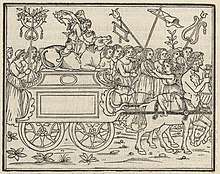 Triumphal car | |
| Author | Francesco Colonna |
|---|---|
| Original title | Hypnerotomachia Poliphili, ubi humana omnia non nisi somnium esse docet. Atque obiter plurima scitu sane quam digna commemorat. |
| Translator | Joscelyn Godwin |
| Country | Italy |
| Language | Italian / Latin |
| Genre | Romance, allegorical fantasy |
| Publisher | Aldus Manutius |
Publication date | 1499 |
Published in English | 1999 |
| Media type | Print (hardcover) |
History
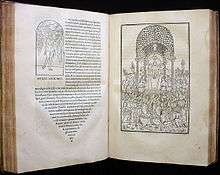
The Hypnerotomachia Poliphili was printed by Aldus Manutius in Venice in December 1499. The author of the book is anonymous. However, an acrostic formed by the first, elaborately decorated letter in each chapter in the original Italian reads "POLIAM FRATER FRANCISCVS COLVMNA PERAMAVIT", which means "Brother Francesco Colonna has dearly loved Polia". Despite this clue, the book has also been attributed to Leon Battista Alberti, and earlier, to Lorenzo de Medici. Manutius himself claimed that the author was a different Francesco Colonna, a wealthy Roman governor. The identity of the illustrator is less certain than that of the author.
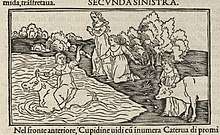
The subject matter of the book lies within the tradition (or genre) of the Romance. It follows the conventions of courtly love, which in 1499 continued to provide engaging thematic matter for the Quattrocento aristocrats. The Hypnerotomachia Poliphili also draws from Renaissance humanism where arcane writings are a demonstration of classical thought.
The text of the book is written in a bizarre Latinate Italian. Without explanation, the text is full of words based on Latin and Greek roots. The book, however, also includes words from the Italian language and illustrations which include Arabic and Hebrew words. Moreover, Colonna would invent new forms of language when those available to him were inaccurate. The book also contains some uses of Egyptian hieroglyphs, but they are not authentic. Most of them have been drawn from a late antique text of dubious origin called Hieroglyphica.
The Hypnerotomachia Poliphili, set in 1467, consists of a series of precious and elaborate scenes involving the title character, Poliphilo ("friend of many things" from the Greek words polloi meaning "many" and philos meaning "friend"). In these scenes, Poliphilo wanders a bucolic-classical dreamland in search of his love, Polia ("many things"). The author's style is elaborately descriptive and unsparing in its use of superlatives. The text makes frequent references to classical geography and mythology, mostly by way of comparison.
The book has long been sought after as one of the most beautiful incunabula ever printed.[1] The typography is famous for its quality and clarity. Its roman typeface, cut by Francesco Griffo, is a revised version of a type which Aldus had first used in 1496 for the De Aetna of Pietro Bembo. The type is thought to be one of the first examples of the roman typeface, and in incunabula, it is unique to the Aldine Press. The type was revived by the Monotype Corporation in 1923 as "Poliphilus".[2] In 1929, Stanley Morison directed another revival of the earlier version of Griffo's type. It was called "Bembo".
The Hypnerotomachia Poliphili is illustrated with 168 exquisite woodcuts showing the scenery, architectural settings, and some of the characters Poliphilo encounters in his dreams. They depict scenes from Poliphilo's adventures and the architectural features over which the author rhapsodizes, in a simultaneously stark and ornate line art style. This integrates perfectly with the type, an example of typographic art.
The illustrations are interesting because they shed light on Renaissance man's taste in the æsthetic qualities of Greek and Roman antiquities. In the United States, a book on the life and works of Aldus Manutius by Helen Barolini was set within pages that reproduce all the illustrations and many of the full pages from the original work, reconstructing the original layout.[3]
The psychologist Carl Jung admired the book, believing the dream images presaged his theory of archetypes. The style of the woodcut illustrations had a great influence on late nineteenth century English illustrators, such as Aubrey Beardsley, Walter Crane, and Robert Anning Bell.
In 1592, in a London edition, "R. D." (who is believed to be Robert Dallington) partially translated the Hypnerotomachia Poliphili. Here, it was given its best known English title, The Strife of Love in a Dream.[4] In 1999, a first complete English translation by musicologist Joscelyn Godwin was published.[5] However his translation uses standard, modern language, rather than following the original text's pattern of coining and borrowing words.
Since the 500th anniversary in 1999, several other modern translations have been published. These include a translation into modern Italian as part of the (volume 1: fac-simile; volume 2: translation, introductory essays and more than 700 pages of commentary) edition by Marco Ariani and Mino Gabriele;[6] into Spanish by Pilar Pedraza Martínez;[7] into Dutch with one volume of commentary by Ike Cialona;[8] into German, with commentary inserted into the text, by Thomas Reiser;[9] and partly into Polish by Anna Klimkiewicz.[10]
A complete Russian translation by the art historian, Boris Sokolov is now in progress, of which the "Cythera Island" part was published in 2005 and is available online. The book is planned as a precise reconstruction of the original layout, with Cyrillic types and typography by Sergei Egorov.
Ten of the monuments described in the Hypnerotomachia were reconstructed with computer graphics and were first published by Esteban A. Cruz in 2006[11] and in 2012.[12] In 2007, Cruz established a full, design-study project Formas Imaginisque Poliphili, an ongoing independent research project with the objective of reconstructing the content of the Hypnerotomachia Poliphili, through a multi-disciplinary approach, and with the aid of virtual and traditional reconstruction technology and methods.
Plot summary
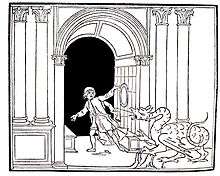
The book begins with Poliphilo, who is spending a restless dream filled night because his beloved, Polia, has shunned him. Poliphilo is transported into a wild forest, where he becomes lost, encounters dragons, wolves and maidens and a large variety of architectural forms. He escapes, and falls asleep once more.
He then awakens in a second dream, a dream within the first. He is taken by nymphs to meet their queen, and there he is asked to declare his love for Polia, which he does. He is then directed by two nymphs to three gates. He chooses the third, and there he discovers his beloved. They are taken by some more nymphs to a temple to be engaged. Along the way they come across five triumphal processions celebrating their union. They are then taken to the island of Cythera by barge, on which Cupid is the boatswain. On Cythera, they see another triumphal procession celebrating their union. The narrative is interrupted, and assumed by a second voice, as Polia describes Poliphilo's erotomania from her own point of view.
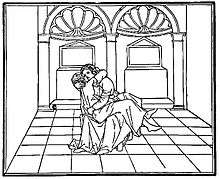
Poliphilo then resumes his narrative (from one-fifth of the way through the book). Polia rejects Poliphilo, but Cupid appears to her in a vision and compels her to return and kiss Poliphilo, who has fallen into a deathlike swoon at her feet. Her kiss revives him. Venus blesses their love, and Poliphilo and Polia are united at last. As Poliphilo is about to take Polia into his arms, Polia vanishes into thin air and Poliphilo wakes up.
Gallery
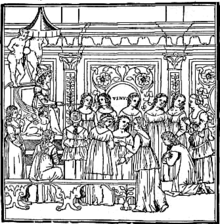 Poliphilo kneels before Queen Eleuterylida
Poliphilo kneels before Queen Eleuterylida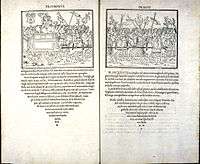
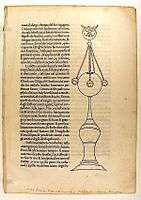
Allusions/references in other works
- The book is briefly mentioned in The Histories of Gargantua and Pantagruel (1532 - 1534) by François Rabelais. He writes, "Far otherwise did heretofore the sages of Egypt, when they wrote by letters, which they called hieroglyphics, which none understood who were not skilled in the virtue, property, and nature of the things represented by them. Of which Orus Apollon hath in Greek composed two books, and Polyphilus, in his Dream of Love, set down more". (Book 1, chapter 9)
- Liane Lefaivre and other scholars regard the 16th century Gardens of Bomarzo to be illustrations of the Hypnerotomachia Poliphili.[13]
- In the preface to her first novel, Ibrahim ou l'illustre bassa (1641), Madeleine de Scudéry advises novelists to avoid ornate descriptions like "Poliphile in his dreams, who hath set down most strange terms" (1652 English translation).
- Hypnerotomachia Poliphili: Re-Discovering Antiquity Through The Dreams Of Poliphilus (2007) by Esteban Alejandro Cruz features more than fifty original colour reconstructions of the architecture and topiary gardens of eight monuments described in the Hypnerotomachia Poliphili. They are titled, "A Great Pyramid", "A Great Hippodromus", "An Elephant bearing an Obelisk", "A Monument to the Un-Happy Horse", "The Grand Arch", "The Palace and Gardens of Queen Eleutirillide (Liberty)", "The Temple to Venus Physizoa", and "The Polyandrion (Cemetery of Lost Loves)".
- Hypnerotomachia Poliphili: An Architectural Vision from the First Renaisssance (2012) by Esteban Alejandro Cruz, with more than 160 colour reconstructions, revising the previous monuments from his first book, and adding a few others: "The Bath of the Five Nymphs", "A Majestic Bridge", "A Fountain Dedicated to the Mother of all Things", "An Ancient Port", and "The Displuvium Garden and its "Curious" Obelisk".
- Polyphilo: or The Dark Forest Revisited - An Erotic Epiphany of Architecture (1992) is a modern re-writing of Polyphilo's tale by Alberto Pérez-Gómez. Perez-Gomez has included a non-fictional preface which introduces the Hypnerotomachia Poliphili.
- Gypnerotomahiya (Гипнэротомахия, 1992) is an eight-minute Russian animation directed by Andrey Svislotskiy of Pilot Animation Studio LOOSELY based on the novel.[14]
- The 1993 novel, The Club Dumas by Arturo Pérez-Reverte mentions the 1545 edition of the Hypnerotomachia (chapter 3). The book is again mentioned in Polanski's 1999 film, The Ninth Gate, based loosely on Pérez-Reverte's novel (this time, by its Italian title, La Hypnerotomachia di Poliphilo).
- The title and many themes of John Crowley's 1994 novel, Love and Sleep (part of his Ægypt series) were derived from the Hypnerotomachia.
- Geerten Meijsing's 2000 novel, Dood meisje refers in many ways to the Hypnerotomachia.
- In the 2004 novel, The Rule of Four by Ian Caldwell and Dustin Thomason, two students try to decode the mysteries of Hypnerotomachia Poliphili.[15]
- Umberto Eco's 2004 novel, The Mysterious Flame of Queen Loana features a protagonist whose doctoral thesis was written on the Hypnerotomachia.
Notes
- Schuessler, Jennifer (23 July 2012). "Rare Book School at the University of Virginia". The New York Times. Retrieved 24 July 2012.
- Poliphilus Font Family by Monotype Design Studio.
- Barolini, Helen. Aldus and His Dream Book: An Illustrated Essay. New York: Italica Press, 1992.
- Robert Dallington [presumed] (1592), The Strife of Love in a Dream. In 1890 a limited (500 copies) edition of the first book was published by David Nutt in the Strand. This was edited by Andrew Laing. Online version at the Internet Archive, accessed on 2010-02-08.
- Joscelyn Godwin (transl.) (1999), Hypnerotomachia Poliphili, the Strife of Love in a Dream, a modern English translation, set in the Poliphilus typeface. Thames & Hudson. ISBN 0-500-01942-8. Paperback edition published in 2005.
- Marco Ariani, Mino Gabriel (edd., transl., comm.) (1998sqq.), Francesco Colonna: Hypnerotomachia Poliphili, Milan: Adelphi (Classici 66) ISBN 978-8-845-91424-9. Paperback edition ISBN 978-8-845-91941-1.
- Pilar Pedraza Martínez (transl.) (1999), Francesco Colonna: Sueño de Polífilo, Barcelona: El Acantilado 17, ISBN 978-8-495-35905-6.
- Ike Cialona (transl., comm.) (2006), Francesco Colonna: De droom van Poliphilus (Hypnerotomachia Poliphili), Amsterdam: Athenaeum – Polak & Van Gennep, ISBN 978-9-025-30668-7.
- Thomas Reiser (transl., comm.) (2014), Francesco Colonna: Hypnerotomachia Poliphili, Interlinearkommentarfassung, Breitenbrunn: Theon Lykos 1a, ISBN 978-1-499-20611-1.
- About the first 100 pages concluding a monograph by Anna Klimkiewicz (transl., comm.) (2015), Hypnerotomachia Poliphili Francesca Colonny, Kraków: Wydawnictwo Uniwersytetu Jagiellońskiego, ISBN 978-83-233-3908-3.
- Esteban Alejandro Cruz (2007), Hypnerotomachia Poliphili: Re-Discovering Antiquity Through The Dreams Of Poliphilus
- Esteban Alejandro Cruz (2012), "Hypnerotomachia Poliphili: An Architectural Vision from the First Renaissance"
- An object of material culture 2XD website October 2014.
- Animator website (Russia)
- Joscelyn Godwin (2004), The Real Rule of Four: The Unauthorized Guide to The New York Times Bestseller. ISBN 1-932857-08-7.
References
- Blunt, Anthony, "The Hypnerotomachia Poliphili in Seventeenth Century France", Journal of Warburg and Courtauld, October 1937
- Fiertz-David, Linda. The Dream of Poliphilo: The Soul in Love, Spring Publications, Dallas, 1987 (Bollingen Lectures).
- Gombrich, E.H., Symbolic Images, Phaidon, Oxford, 1975, "Hypnerotomachiana".
- Lefaivre, Liane. Leon Battista Alberti's Hypnerotomachia Poliphili: Re-cognizing the architectural body in the early Italian Renaissance. Cambridge, Massachusetts [u.a.]: MIT Press 1997. ISBN 0-262-12204-9.
- Pérez-Gómez, Alberto. Polyphilo or The Dark Forest Revisited: An Erotic Epiphany of Architecture. Cambridge, Massachusetts: MIT Press 1992. ISBN 0-262-16129-X, Introduction by Alberto Pérez-Gómez.
- Schmeiser, Leonhard. Das Werk des Druckers. Untersuchungen zum Buch Hypnerotomachia Poliphili. Maria Enzersdorf: Edition Roesner 2003. ISBN 3-902300-10-8, Austrian philosopher argues for Aldus Manutius' authorship.
- Tufte, Edward. Chapter in Beautiful Evidence
- Cruz, Esteban Alejandro, Hypnerotomachia Poliphili: Re-discovering Antiquity Through the Dreams of Poliphilus Victoria: Trafford Publishing, 2006. ISBN 1-4120-5324-2. Artist reconstructions of the architecture and landscapes described by Poliphilus during his amorous quest through Antiquity.
- Cruz, Esteban Alejandro, "Hypnerotomachia Poliphili: An Architectural Vision from the First Renaissance" London: Xlibris Publishing, 2012. VOL 1: 978-1-4628-7247-3, VOL 2: 978-1-4771-0069-1. A second book of what seems to become a series of publications on the subject.
External links
| Wikimedia Commons has media related to Hypnerotomachia Poliphili. |
The original 1499 edition
- Hypnerotomachia Poliphili : ubi humana omnia non nisisomnium esse docet atque obiter plurima scitu sane quam digna commemorat: digital version, from the Boston Public Library collection at Archive.org
- The Electronic Hypnerotomachia: facsimile and discussion, from the MIT Press
- high-resolution photographs From the Rare Book and Special Collections Division at the Library of Congress
- Complete digital surrogate: of copy in the Menil Collection Library in Houston Texas.
- high-resolution scan of a copy in the Herzog August Bibliothek Wolfenbüttel
- In PDF, TXT (ZIP), and RTF (ZIP) formats from Liber Liber
- Facsimile of thirteen pages, with a five-minute reading from Godwin's 1999 translation (from the State Library of Victoria)
- van der Lee, Peter. Hypnerotomachia Poliphili. vimeo.com.
The 1592 English edition
- Hypnerotomachia at Project Gutenberg
- The Strife of Love in a Dreame In PDF or DJVU, and beta flip-book formats
The French editions
- Les Livres D’Architecture at Architectura
- 1600 Edition created by Béroalde de Verville at e-rara.ch, Swiss digital library's C.G. Jung collection
- 1600 edition by Béroalde de Verville at Bibliothèques Virtuelles Humanistes
- Woodcuts from the French edition with iconographic descriptions in the Warburg Institute Iconographic Database
The Russian edition
Background and interpretation
- Book of the Month article from the Glasgow University Library's Special Collections Department
- Prints & People: A Social History of Printed Pictures, an exhibition catalog from The Metropolitan Museum of Art (fully available online as PDF), which contains material on Hypnerotomachia Poliphili (see index)
Research Projects
- Formas Imaginisque Poliphili: Imaginary models of Poliphilus revealed. Reconstruction of the architecture, gardens, landscapes, monuments, interiors, accessories, and objects as described in the Hypnerotomachia Poliphili through a multi-disciplinary research platform, and with the aid of virtual applications and methods used in the Cultural Heritage Industry.